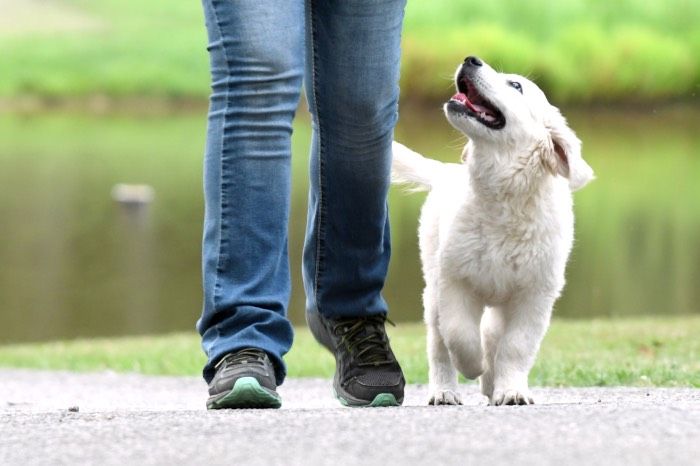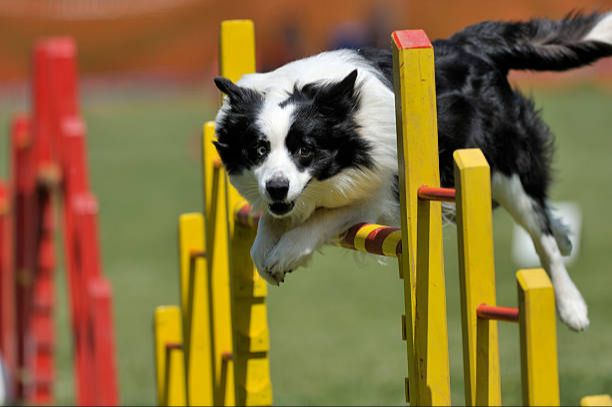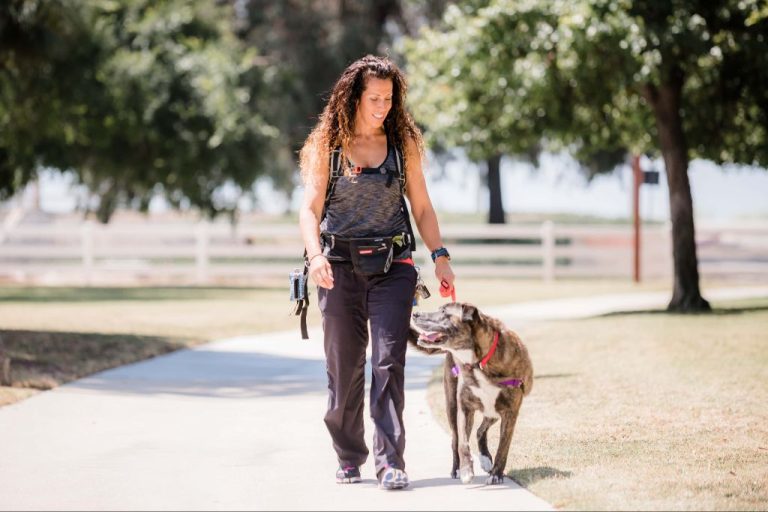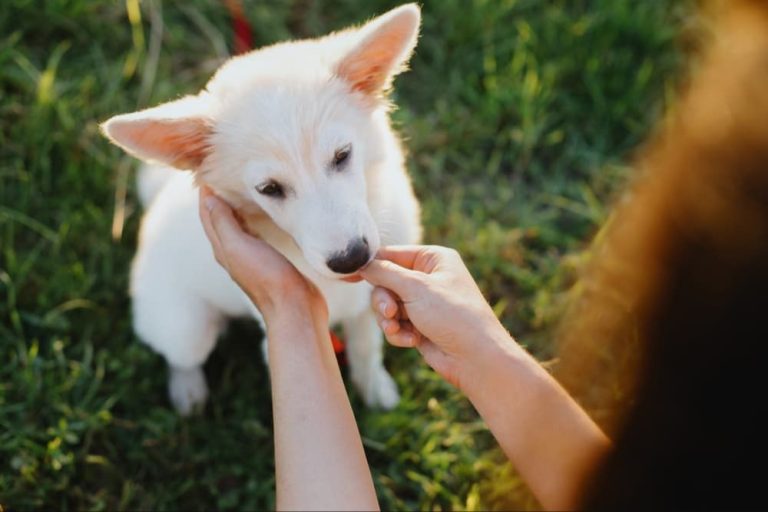Teaching Your Dog Basic Commands: Sit, Stay, And Down
Having a well-trained dog comes with many benefits for both the dog and owner. Teaching your dog basic obedience commands like sit, stay, and down is an important foundation for establishing good communication and behaviour. A trained dog is more confident, less stressed, and able to better focus on tasks. For the owner, a trained dog is more enjoyable to be around and easier to handle in public. Taking the time to train a dog in basic commands also builds a stronger bond through the shared experience. It’s a worthwhile investment that pays off in a more harmonious life together.
This article will cover the process of teaching three fundamental commands: sit, stay, and down. We’ll look at the importance of being consistent, offering positive reinforcement, and setting your dog up for success. Tips will be provided to troubleshoot any difficulties that arise during training. With patience and persistence, these basic skills can be mastered. It simply requires understanding the proper techniques, committing to regular short training sessions, and celebrating successes along the way. The result is a dog that responds reliably to cues, enhancing your relationship built on communication and trust.
Preparing to Train
Before you start training your dog, it’s important to gather the proper supplies to set yourself and your pup up for success. Having the right training equipment on hand will make the process smoother. Be sure to stock up on tasty, healthy training treats that your dog loves. Small soft treats are ideal so you can reward your dog frequently throughout each training session. You’ll also need a properly fitted collar or harness and a 6 foot leash for training. A clicker is another useful training tool to mark desired behaviors precisely. Prepare everything you’ll need in advance so you’re ready to focus fully on your dog during training sessions without any distractions.
Choosing the right location for training is also key. Look for a quiet area without too many potential distractions around so your dog can focus. Your backyard, a room in your home with the doors closed, or an enclosed dog park are good options. Always train your dog on leash at first for control. As your dog masters basic commands, you can practice in more distracting environments to proof the behaviors.
Before starting a training session, make sure your dog has had a chance to relieve themselves and get some exercise to burn off excess energy. Keep initial training sessions short, around 5-10 minutes for puppies or dogs new to training. End each session on a positive note with rewards so your dog enjoys the experience.
Teaching Sit
Teaching your dog to sit is often the first command trained. Here is a step-by-step process for teaching your dog to sit on command:
Start with your dog standing in front of you. Hold a treat at their nose level, then slowly raise it up and back over their head. As you move the treat up, your dog’s head will follow the treat and their hindquarters will lower down into a sit position. Once they are sitting, say your command word “Sit” then give them the treat and praise.
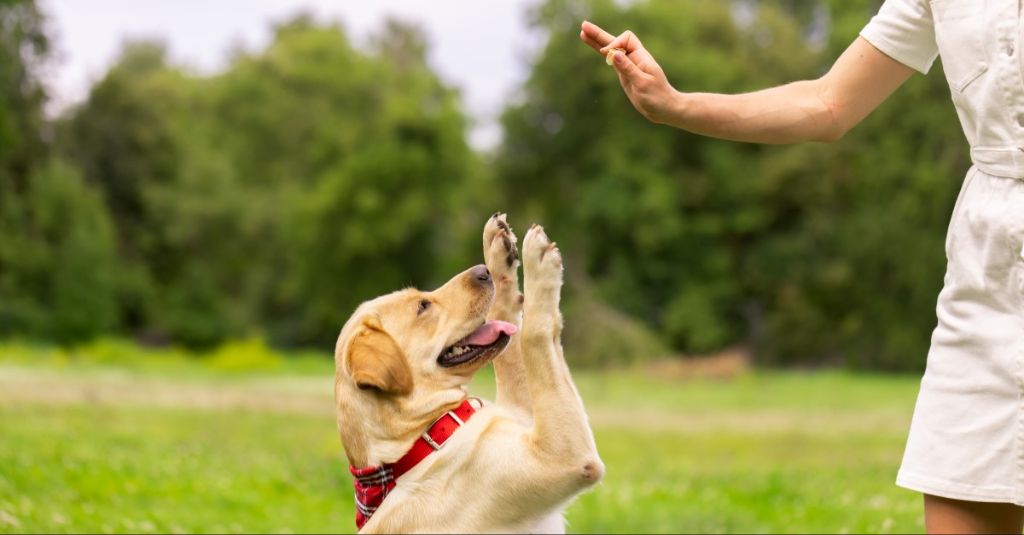
Use a hand signal as well during training. As your dog sits, hold your hand out palm facing down and sweep it down towards the floor. This hand signal will eventually be used to tell your dog to sit without needing a treat lure. According to the RSPCA, using a hand signal can help reinforce the verbal command (1).
After a few repetitions, start saying your command word “Sit” before moving the treat. Give your dog a chance to sit first. If they do, reward them. If not, use the treat to lure them into position. Eventually your dog will learn to sit just from hearing the verbal cue.
Wean off using a treat lure by shifting to a reward-based system. Ask for a sit using your hand signal and verbal command, then reward with a treat if they comply. This treat becomes a reward rather than a lure. With repetition, your dog will respond to just the verbal and hand signal cue.
(1) https://www.rspca.org.uk/adviceandwelfare/pets/dogs/training/sit
Teaching Stay
Once your dog has mastered the sit command, you can start working on teaching them to stay. The stay command builds on the sit command by requiring your dog to maintain the sitting position until you release them with a cue word like “okay” or “free.”
Start by asking your dog to sit, using the hand signal and verbal command you taught them for sit. Once they are sitting, put your open palm in front of their face in a “stop” signal, say “stay” firmly but calmly, and take one step back. Wait 3-5 seconds, then return to your dog and reward with praise and a treat. Gradually increase the duration of the stay from a few seconds to 30 seconds or longer over multiple training sessions. Remember to reward and release your dog from the stay each time.
You can make stay more challenging by increasing distance instead of just duration. Take gradual steps back from your dog over multiple sessions. Eventually work up to leaving the room briefly while your dog remains in a stay. Always return and reward before releasing your dog from the stay. With practice, your dog will learn to wait until you give the release cue, no matter how far away you move or how long you are gone (source: How to train a dog to stay – RSPCA). Stay is an important foundation for more advanced training.
Teaching Down
One of the easiest ways to teach the “down” command is to lure your dog into a down position using treats. Start with your dog in a sitting position. Hold a treat in your hand down by your dog’s chest. Slowly move the treat towards the floor while saying “down” in a calm, clear voice. Your dog will likely follow the treat with their nose, which should guide them into a down position. Once they are laying down, immediately praise them and give them the treat. Practice this multiple times until your dog reliably follows the lure into a down.
As your dog learns the down command through luring, start saying “down” before you present the treat. Give the treat and praise as soon as they lay down. Gradually phase out the need to use a treat lure at all. Just say “down,” wait for them to lay down, then reward. With consistent practice, your dog will learn to lie down on verbal command alone.
It’s important to practice the down command in various locations, not just in one spot. This helps your dog understand that “down” means lie down no matter where they are. Mix up training sessions indoors and outdoors, while stationary and during walks. Changing locations and contexts will solidify the behavior.
Be patient during training and keep sessions positive and rewarding. Eventually, your dog will learn to promptly obey the “down” cue. This is an important command for safety and establishing good manners.
Sources:
https://www.rspca.org.uk/adviceandwelfare/pets/dogs/training/liedown
https://www.akc.org/expert-advice/training/how-to-teach-your-dog-to-lie-down/
Training Tips
Dog training requires consistency, patience, and keeping training sessions short and rewarding. It’s important to end each session on a positive note by rewarding your dog for good behavior. Training sessions should be no longer than 10-15 minutes for puppies, and 20-30 minutes for adult dogs. Try to train in frequent, short sessions rather than long, infrequent sessions. Consistency is key – everyone in the household should use the same commands. Be patient and remember that changing behavior takes time. Reward good behavior and ignore unwanted behavior instead of punishing. Use positive reinforcement techniques like treats, praise, or play to encourage desired behaviors. Setting your dog up for success will build their confidence and reinforce the behaviors you want. Small, achievable goals are the key to effective training. End each session when your dog is still focused and engaged to keep it positive. With short, engaging, rewarding training sessions and consistency, you’ll be well on your way to teaching your dog basic commands.
Troubleshooting
Even with the best training methods, you may encounter issues like your dog not responding reliably to commands or losing interest during training sessions. Don’t get discouraged! There are solutions to get your dog’s training back on track. Here are some troubleshooting tips:
- Make sure you have your dog’s attention before asking for a command. Say their name and give them a moment to focus on you. Getting their eyes on you first helps improve response.
- Go back to basics and practice in an area with minimal distractions. Build up their skills slowly by increasing distractions over time.
- Keep training sessions short, interesting, and reward-based. End on a positive note so your dog is left wanting more.
- Consider getting advice from an experienced dog trainer if your dog is consistently not responding to training. An expert can identify issues and provide solutions tailored to your dog.
- Check that you are using proper training mechanics like timing of rewards and consistency of cues. Subtle errors can undermine your dog’s progress.
- Make sure your dog is getting adequate physical and mental exercise outside of training. A dog that is bored or has pent-up energy may have trouble focusing.
- Rule out medical issues by scheduling a veterinary exam. Pain, illness or changes in senses could affect your dog’s ability to respond.
- Be patient and stay positive! With persistence and creativity, you can get your dog’s training back on track.
Don’t get discouraged if you hit some bumps in training. Troubleshooting and adjusting your approach can get you and your dog over the hurdles. Consistency, patience and keeping sessions fun will have your dog mastering commands in no time.
Expanding Training
Mastering the basic commands of sit, stay, and down provides an important foundation for training your dog additional skills. Once your dog understands these core commands, they have learned how to focus, listen, and follow your lead. This establishes the groundwork for teaching more advanced or complex behaviors.
For example, once your dog reliably sits, stays, and lies down on command, you can begin linking these actions together into sequences. A common sequence is asking your dog to sit and stay, then lie down and stay, before finally releasing them to come. Chaining commands in this way builds their impulse control.
You can also build on these basics to train useful behaviors like coming when called, leaving something alone when asked, walking calmly on a leash, waiting at doors, and more. Because your dog now understands the reward system and that you are directing their actions, it will be easier for them to generalize training to new contexts.
Additionally, mastering sit, stay, and down gives you management skills for real-life situations. You can ask for a sit when guests arrive, a stay when a door opens, or a down to settle during dinner. The fundamentals offer practical tools to reinforce good manners.
With patience and positive reinforcement, your dog’s education can continue to grow after conquering the core curriculum of sit, stay, and down. Their focus and willingness to work with you has been established through these foundational commands.
Conclusion
Training your dog basic commands like sit, stay, and down is an important part of building a healthy relationship and ensuring good behavior. Consistency and positivity are key when teaching these commands. Always use rewards like treats or praise to reinforce desired behaviors. Be patient as your dog learns. Training takes time and repetition, but the effort pays off through a well-behaved companion.
Start training early and keep daily short sessions. Use clear, simple verbal cues and hand signals. Give your dog a chance to succeed by minimizing distractions during initial training. If your dog struggles with a command, take a step back and make it easier. With time and positive reinforcement, your dog will master these basic skills.
Sit, stay, and down provide a foundation for good manners and response to direction. Keep working on training throughout your dog’s life. A well-trained dog is a pleasure to own. Consistent rewarding of their training will deepen the bond with your loyal companion.
References
This article refers to the following sources and reference materials:
- The Association of Professional Dog Trainers. “The APDT Guide to Dog Training and Care.” APDT Press, 2019.
- McDevitt, Leslie. “Control Unleashed: Creating a Focused and Confident Dog.” Clean Run Productions, 2007.
- Braastad, Turid Rugaas. “On Talking Terms with Dogs: Calming Signals.” Dogwise Publishing, 2006.
- Reid, Pamela. “The Power of Positive Dog Training.” Howell Book House, 2001.
- American Kennel Club. “AKC’s Complete Guide to Basic Dog Training.” Simon & Schuster, 2006.

